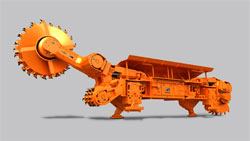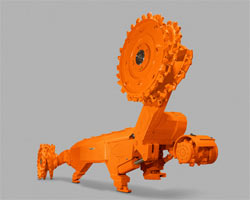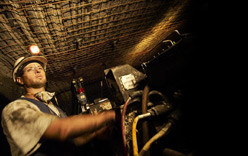EQUIPMENT SELECTION
c) Shearers
Although this section should strictly be titled "coal cutting machines", in most of the world, and certainly in Australia, this involves shearers. The only other cutting machines of note with modern longwalls are ploughs which are dealt with briefly in the Longwall part of the Fundamentals of Coal Mining module of this web site. There are no ploughs in use in Australia at present.
While there have been many developments in shearers over the years, these have been in the main related to increases in size, power, control, monitoring and removal of cut coal. Such developments have certainly been major, but the essentials of the shearer are little changed since they were originally introduced into Australia.

A modern large shearer (thick seam)
viewed from the goaf side.
Photo courtesy of Joy Manufacturing Company Pty Ltd
Some of the biggest developments have been in size and power, largely associated with high production mines in thick seams. Shearers weighing up to 100 tonnes supplying 1 MW of power to the ranging arms are now in use with increases in the size of shearer haulage equipment to match speed to the power available.
The basic shearer support frames are similar to older versions only more robust, though where space allows a hydraulically controlled roll frame is included so the shearer is less dependent on the attitude of the AFC for controlling the profile of the next shear.

A view of the shearer in the previous illustration
from the face side.
Photo courtesy of Joy Manufacturing Company Pty Ltd
While the strength of all components has been increased over the years (usually involving an increase in size), for thinner seams as well as thick seams, and in particular the strength of ranging arms, close attention has been paid to maximising clearance around the shearer for coal flow. A badly designed shearer can incur a lot of wasted power pushing or grinding coal which has been cut but is trapped within the shearer structure.
As part of this attention to coal clearance, shearer drum design is of major importance, involving the number, depth and space between vanes, pick lacing and size and drum rotation speed, all related to shearer speed and coal strength and structure (and roof or floor strata if that is to be cut on a regular basis). Ventilation of the face side of cutter drums, assisted by the use of hollow shaft drums allowing air flow to the face side, is important in gassy seams.
Dust minimisation and control is another area which has received considerable attention by correct design of cutter picks and pick lacing, by good coal clearance and by the use of water sprays. The latter can be considered in two parts, application of spray water to the pick points and the use of spray curtains to keep dust between the shearer and the face so that it is prevented from mixing with the airstream in which personnel are operating. Usually the spray water is also used for machine cooling and is applied via a pump to increase the pressure above that of the mine reticulation system.
Summarising, the main points for consideration in shearer design are:
- Power requirements must be able to handle the likely worst conditions as well as the required production levels;
- Component strength, in particular for ranging arms;
- Ability to cut far enough into the gate roads to allow excavation when required to enable advance of the AFC drives;
- Ability to cut below the AFC pan line to correct cutting profiles;
- Machine size with regard to transport around the mine with minimum dismantling (cutting drums and ranging arms can be removed reasonably easily);
- Coal clearance ability around the shearer, including beneath the shearer body and when cutting in either direction;
- Machine size in relation to face ventilation (a shearer is effectively a mobile regulator on the face);
- Available control systems (radio, umbilical, local manual – it is usually beneficial for all 3 to be available);
- Availability of automated systems; and
- Availability of monitoring and fault diagnostics.
- http://www.min-pan.krakow.pl/Wydawnictwa/GSM2443/flook-leeming.pdf Paper by Joy Mining personnel describing recent (pre 2008), mostly large equipment produced by the Company (includes info on continuous miners and flexible conveyors for development panels.

